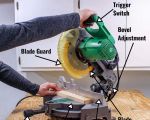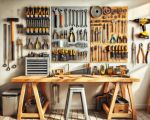
May 17, 2025
Introduction to DIY Farmhouse Furniture
Building your own farmhouse-style furniture can be one of the most rewarding and fulfilling home improvement projects you can take on. Not only does it add a personalized touch to your space, but it also helps you save money compared to buying ready-made pieces. Plus, there's something incredibly satisfying about using your own hands to craft beautiful, functional pieces for your home.
As someone who's worked on several DIY farmhouse furniture projects, I can tell you that the process is easier than you might think. Whether you’re a complete beginner or someone with some woodworking experience, these tips will help you create stunning farmhouse furniture pieces. Let’s dive into some of the essential tips for getting started on your next project.
1. Choose the Right Materials for Your DIY Farmhouse Furniture
Before you start building, it’s important to select the right materials. For a rustic farmhouse look, wood is the ideal choice. When shopping for wood, consider options like pine, oak, or reclaimed wood. Reclaimed wood is a great choice for farmhouse furniture because it offers character and history, giving each piece a unique touch.
While buying new wood is perfectly fine, reclaimed wood adds that authentic charm that defines farmhouse style. It's a bit more work to source and prep, but the result is worth it.
Tip: Look for lumber at local salvage yards or online marketplaces. You can often find beautiful, affordable pieces of reclaimed wood.
2. Master the Basic Tools for Building Farmhouse Furniture
Having the right tools is crucial when it comes to DIY projects. You don’t need to go out and buy a whole new set of tools, but there are a few essentials that will make your work much easier and more precise:
Circular Saw: Ideal for making straight cuts through your wood. If you're just starting, a basic circular saw will serve you well.
Power Drill: Essential for drilling holes and driving screws.
Measuring Tape: Accurate measurements are crucial for building furniture that fits well and looks professional.
Sander: For smoothing rough edges and surfaces to give your furniture a polished, finished look.
Clamps: These will help you hold your pieces in place while you’re assembling them.
Tip: If you’re working with large pieces of wood, consider investing in a miter saw to make precise angled cuts. It’s a tool that can be used on many projects beyond just farmhouse furniture.
3. Start with Simple Projects to Build Your Confidence
If you're new to woodworking, it's a great idea to start with simpler projects. A basic farmhouse bench or coffee table is a perfect entry point for beginners. These projects usually involve straightforward cuts and assembly, giving you a solid foundation for more complex designs later on.
Example: I started with a simple wooden bench for my front porch. It was a small project, but it taught me so much about measuring, cutting, and assembling pieces.
Once you gain confidence, you can move on to more complex projects like a farmhouse dining table or even a rustic bookshelf.
4. Understand the Importance of Proper Measurement and Planning
One of the biggest mistakes beginners make when building furniture is not taking the time to properly measure and plan out their projects. Before you start cutting, always take precise measurements of your space and the furniture you want to build.
Draw up a detailed plan with measurements before you start cutting. A blueprint will ensure that you don’t waste materials or time, and it will help you visualize your final piece. There are plenty of free farmhouse furniture plans available online that you can download or use for inspiration.
Tip: When measuring, always double-check your dimensions. A small mistake can lead to gaps or a piece that doesn’t fit properly.
5. Finishing Touches: Staining and Painting Your DIY Farmhouse Furniture
The finish you choose for your furniture plays a huge role in achieving the rustic farmhouse look. Whether you prefer a natural wood finish or something a little more colorful, the finish should reflect the charm and warmth that farmhouse furniture is known for.
For a natural look, a simple wood stain can bring out the grain and character of the wood. If you’re going for a more distressed, worn look, try using a combination of sanding, painting, and then distressing to give your furniture that lived-in feel.
Tip: If you're unsure about staining or painting, try experimenting on scrap pieces of wood first. It’s better to make mistakes on smaller pieces!
6. Don’t Rush the Process—Enjoy the Journey!
One of the most enjoyable aspects of building your own farmhouse furniture is the process itself. It’s easy to get excited and rush through things, but take your time to appreciate the craftsmanship you're developing. Every piece you build will be a unique reflection of your style, creativity, and patience.
Example: I remember when I built my first farmhouse coffee table—it was an imperfect piece, but the sense of accomplishment was incredible. Now, it's one of my favorite pieces in the house!
7. Where to Find Inspiration for Your Farmhouse Furniture Projects
If you’re looking for inspiration for your next DIY farmhouse project, the internet is filled with countless blogs, Pinterest boards, and Instagram accounts dedicated to rustic home decor. One of my favorite sources of inspiration is Pinterest, where you can find everything from modern farmhouse designs to vintage-inspired furniture pieces.
Tip: If you prefer hands-on inspiration, visit local antique shops or flea markets for pieces you can restore or use for design ideas!
Building farmhouse furniture is a fun and rewarding experience. With the right tools, materials, and mindset, you can create beautiful, functional pieces that add warmth and charm to your home. Whether you’re starting with a small project or jumping into a larger piece, remember to enjoy the process.








